This module is designed to guide you through a process of building the habit of Revising in your students.
It invites you to undertake some rich activities in the form of learning experiments in your classrooms, helping you to organise your own discoveries and extend your own understanding of the power of building students’ learning habits.
Work through sections 1 – 4 where you will consider:
- Revising and how it develops. Unpick the revising grid and plot where your students are now
- Taking revising into classroom culture. Think how to improve your classroom culture to better support revising.
- Teaching for learning; activities and talk. Look for ways of building revising into learning activities/tasks and the learning language.
- Team reflection and planning. Share the impact of your experiments with colleagues and plan what you need to do next.
Section 1: Revising and how it develops
What do we mean by Revising?
However well prepared learners are, they have to expect the unexpected. They have to have the readiness to revise as they go along. Good learners are able to change their plans and think on their feet. They are able to be flexible. To be effective at revising, learners need to monitor how things are going and periodically review where they have got to.
Monitoring is the art of looking over your own shoulder as you’re working away at a problem, asking yourself how it’s going.
Getting better at monitoring ( ‘reflection in action’ ) involves cultivating the little voice of self-awareness that keeps the strategic goals in mind, and is ready to change tack if it seems appropriate. A teacher who decides to throw away the lesson plan on the spur of the moment and go with the interesting discussion which is developing, is monitoring. Students can pick up the habit from people who can model it; who have learnt how to learn aloud, i.e. to externalise the thought processes of the vigilant monitor.
Reviewing (‘reflection on action’) means stopping every so often to take stock of progress, and to ensure that any emerging product—an artwork, an essay, a draft business plan—is on track. Reviewing requires the ability to look at your own work with the critical eye of an editor, and not be afraid of the possibility that some corrections may be needed. A writer may put a piece of work aside for a while and then come back to look at it afresh. An athlete may sit down and look at the video of her starting technique to see if any adjustments need to be made. But reviewing is what the low-achieving maths student, for example, is very often unable to do.
What does being a good Reviser involve?
Being able to monitor and review isn’t the whole story of course. To be a good reviser you need other qualities such as your attitude to change and whether you have a sense of standards. If you don’t understand that certain standards are important and why then you are unlikely to bother to make an effort to achieve them. If you have an inflexible frame of mind then again you are unlikely to recognise the need to change your ideas or the way you do something. The Revising grid below takes account of the constituent parts of building the habit of Revising
Our progression grid for Revising has 6 components:
Unpicking the columns; what contributes to a readiness to revise?
The grid columns are things that might combine to make up the skills and attitudes of a reviser.
Overview of the grid
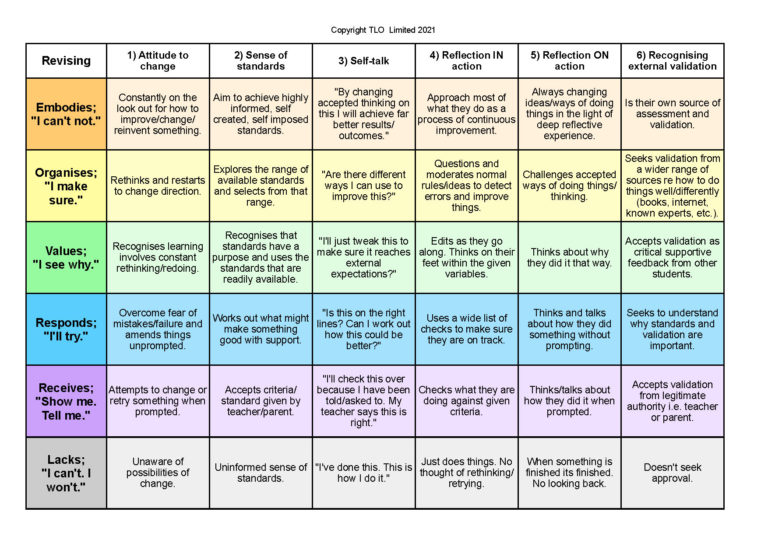 Revising is about the way we work on something to improve it. Whether it be icing a cake, solving a tricky maths problem or creating a well crafted essay, all require effort, retries and determination to satisfy ourselves that the result pleases us. How we tackle such a job isn’t just a case of monitoring as we go along or reviewing the result: it will be influenced by other qualities. Our attitude to change, whether we have a sense of quality and what sort of validation we need. The grid intertwines these important contributors to our growth in the habit of Revising.
Revising is about the way we work on something to improve it. Whether it be icing a cake, solving a tricky maths problem or creating a well crafted essay, all require effort, retries and determination to satisfy ourselves that the result pleases us. How we tackle such a job isn’t just a case of monitoring as we go along or reviewing the result: it will be influenced by other qualities. Our attitude to change, whether we have a sense of quality and what sort of validation we need. The grid intertwines these important contributors to our growth in the habit of Revising.
The learning guru Royce Sadler put it like this: “Students need to be able to judge the quality of what they are producing and be able to regulate what they are doing during the doing itself”.
Take a closer look at what each column of the grid is about…
 1) Attitude to change
1) Attitude to change
How we relate to the change process
For many of us, doing things differently is scary and only for the bold and confident. But if we want students to enjoy achieving their best learning outcomes, we need to scaffold that process by building confidence – helping students move beyond their comfort zone and becoming more flexible as a learner. In the early phases students adapt what they are doing because they are being told and/or supported to do so. But this support pays off at the ‘value’ phase (green) when students feel positive about their efforts and realise learning is all about rethinking and adjusting and redoing, rather than getting it right first time. By the ‘organises’ phase (yellow), students are ready, willing, and able to move beyond making relatively small changes to making wholesale changes or starting again on a different tack.
 2) Sense of standards
2) Sense of standards
How we relate to standards of excellence, quality, and correctness
The next contributory factor in revising what we are doing has to do with how we view quality; whether we have a sense of standards; our view of what’s good, bad or indifferent. In the early phases students accept what they are told about by teachers; what something needs to look like, be like, feel like. Schools are full of them – objectives, criteria, steps to success, outcomes – and constantly trying to achieve them can be dispiriting. But with support and encouragement students are able to begin to think for themselves what makes something good and determine their own standards.
 3) Self-talk
3) Self-talk
The voice of self awareness
Self talk is what we say to ourselves as we learn. The statements capture what someone in each phase of the grid would be thinking. Students may use some of these phrases when talking with you, or in writing from time to time, but mostly self talk goes on inside their heads. We have shown a small flavour of self talk thoughts that teachers can encourage students to imitate. Some relate to standards, others to self monitoring, or flexibility. All such self talk is important in building a revising habit.
 4) Reflection IN action
4) Reflection IN action
Checking of how things are going
This column is about how we monitor what’s happening as we go along; keeping a weather eye on how things are going. Students need help to do this well. They need to know what they are looking for, what they are tracking. Should they look for good things or bad, for feelings, for whether they understand…? It’s a minefield. The early phases shown here relate to monitoring what you are doing against known criteria, and checking the process of doing something itself. Students need these props in the early phases. It’s only in the ‘valuing’ ( green) phase that they become skilled at editing as they go along, having had practice with checklists and criteria in earlier phases.
Look particularly at the difference between ‘value’ and ‘organised’. In the ‘value’ phase the amends, revisions, and re-tries are being done with the original aim/goal/ objective in mind. In the ‘organised’ phase students are prepared to ditch the original plan, ask hard questions, change the rules and change direction. It’s a big and important shift in becoming an independent learner.
 5) Reflection ON action
5) Reflection ON action
The inclination to reflect on what we have achieved
This is the essence of learning from experience although sadly it is not a common inclination. The key here is not simply reflecting on what happened and whether we could have improved, but whether we take heed of such lessons and behave differently next time. This is not a natural skill and will need careful structuring and nurturing. Notice that the early phases are about what happened and are heavily scaffolded. By green students are asking why they did it that way, and by yellow they are challenging those familiar ways of working and rethinking the how in order to achieve better outcomes. It’s a breakout moment.
 6) Recognising external validation
6) Recognising external validation
How we relate to external validation.
The last constituent of revising has to do with how we need and use external validation – the need for a legitimate authority source to confirm that what we are doing is right. When we are chasing facts we need to be sure they are correct. When we are using standards we need to be sure they are sound. In the early phases this authority normally comes from parents and teachers. As students move through the phases there is a move to seeking out experts, dictionaries and original sources. (The internet invariably plays a role here but while it might be a great place to start it’s a terrible place to finish! It needs to be used with discernment.) Sources’ legitimate authority plays into how we revise and improve our learning.
What do you think?
- What have you learned about revising from these descriptions?
- What have you had confirmed?
- What surprised you?
- How have your views changed?
Make a note of…
- Any ideas for practical classroom experiments that these descriptions have triggered
- Which column your students are most secure in.
4. Unpicking the rows; getting better at Revising.
Of course the development of revising does not grow neatly up each column or evenly across the phases in the grid. The five broad phases of dispositional growth (purple – orange) are affective ways in which people may be inclined to behave: we call this inclination ‘mindedness’.
Here is our interpretation of how Revising might grow.
Meaning behind the phases
The phases are drawn from Bloom’s taxonomy of the affective domain.
Phase ‘Receives’ (purple) is about doing something because you are told or expected to.
Phase ‘Responds’ (blue) is about gaining interest and doing things more willingly.
Phase ‘Values’ (green) is a key phase since the student now sees the value of behaving in this way. It’s a win for them; to behave like this is ‘in their interest’. It’s in this phase that the behaviour becomes more secure.
Phase ‘Organises’ (yellow) is the phase in which the student capitalises on this ‘in their interest’ behaviour and gets themselves organised to use it positively.
Phase ‘Embodies’ (orange), known as ‘characterised’ in the original taxonomy. In this phase the student has made this behaviour their own. It has become part of their character; they can’t not do it and they have become highly skilled in doing it.
We urge you to see this progression as long term. Some phases will take years for people to work through; some will never be worked through. None of the phases are inevitable. There is a lifetime of development captured here. Nevertheless the role of a teacher or parent should surely be to encourage and enable this journey.
Lacks: Minded to ‘just do things’
 In this ‘Lacks’ (grey) phase, students are not necessarily aware of doing things well or differently. Once they get going on something they may change it but more for the joy of just doing it. Outcomes maybe rushed or lack finesse, but once completed there may be little interest in revisiting it or in any comments they are offered. External standards are not yet a feature of their world.
In this ‘Lacks’ (grey) phase, students are not necessarily aware of doing things well or differently. Once they get going on something they may change it but more for the joy of just doing it. Outcomes maybe rushed or lack finesse, but once completed there may be little interest in revisiting it or in any comments they are offered. External standards are not yet a feature of their world.
Receives: Minded to check what they do.
 In the Receives (purple) phase, students begin to make checks on how they are doing against given criteria when prompted. They can talk about what they did and sometimes how. They rely on their teachers or parents to validate what they do/have done.
In the Receives (purple) phase, students begin to make checks on how they are doing against given criteria when prompted. They can talk about what they did and sometimes how. They rely on their teachers or parents to validate what they do/have done.
Responds: Minded to understand standards.
 In the Responds (blue) phase students have overcome a fear of mistakes and are more able and willing to monitor what they are doing. They begin to develop the idea of ‘good’ themselves and to understand why given standards are important. They respond positively to supportive feedback and talk reflectively about how they could improve with encouragement.
In the Responds (blue) phase students have overcome a fear of mistakes and are more able and willing to monitor what they are doing. They begin to develop the idea of ‘good’ themselves and to understand why given standards are important. They respond positively to supportive feedback and talk reflectively about how they could improve with encouragement.
Values: Minded to value revising
 In the Values ( green) phase, students understand the importance of keeping a close eye on progress in order to achieve high quality outcomes that meet their goals. They see the point in making changes in the light of the original goal or external standard or internal feedback. They understand the need to learn from previous experiences and realise that learning is all about changing understandings; not just knowing stuff. In so doing they widen the scope of external validation.
In the Values ( green) phase, students understand the importance of keeping a close eye on progress in order to achieve high quality outcomes that meet their goals. They see the point in making changes in the light of the original goal or external standard or internal feedback. They understand the need to learn from previous experiences and realise that learning is all about changing understandings; not just knowing stuff. In so doing they widen the scope of external validation.
Organises: Minded to actively seek alternative strategies
 In the Organises (yellow) phase revising has become a skilful habit; where revising itself raises more questions than answers. Yes, progress is kept under review but now students question the original goal of the activity. They look more widely for validation and may well change to a more productive strategy or a different goal. They use critical feedback positively and are keen to look back on what and how they achieved what they did in order to learn from the experience.
In the Organises (yellow) phase revising has become a skilful habit; where revising itself raises more questions than answers. Yes, progress is kept under review but now students question the original goal of the activity. They look more widely for validation and may well change to a more productive strategy or a different goal. They use critical feedback positively and are keen to look back on what and how they achieved what they did in order to learn from the experience.
Embodies: Minded to exploit previous experience to the full
 In the Embodies ( orange) phase, students make ongoing checks and amends, and major rethinking, in order to meet their own, often more exacting, standards of achievement. Now they tend not to need the the validation of others (marks, grades, exams, quality feedback) because their own critical sense of standards acts as their barometer. They adapt readily to changing circumstances and always reflect on what and how they have done something with the explicit intention of doing it better, more efficiently / differently in the future.
In the Embodies ( orange) phase, students make ongoing checks and amends, and major rethinking, in order to meet their own, often more exacting, standards of achievement. Now they tend not to need the the validation of others (marks, grades, exams, quality feedback) because their own critical sense of standards acts as their barometer. They adapt readily to changing circumstances and always reflect on what and how they have done something with the explicit intention of doing it better, more efficiently / differently in the future.
What do you think?
- What has struck you about the act of revising having read the descriptions above?
- Which phase do you operate in?
- What makes you say that?
Make a note of…
- What you might do to assist your students to make headway in their revising behaviour.
- Any practical ideas the text has triggered.
Activity 1
- Download the Revising Grid as a PDF (not available in this preview version)
- Colour in the cells where you think your pupils are secure.
- Draw a red line across the grid to denote where you think most of the school’s students could and should reach by the time they leave.
- Please take the results of these tasks with you to the Professional Learning Team session shown in Section 4
Section 2: Taking revising into classroom culture
As teachers we are in the habit-forming business. Those habits that we model in front of young people influence the ways in which they perform and behave. Therefore, we need to be sure to foster productive learning habits. If, for example, we offer constructive feedback but fail to require students to act on it, we are not building their inclination to further improve on previous attempts. In such ways do good teachers, albeit inadvertently, stifle the very behaviours they are seeking to promote.
Activity 2: How well does my classroom climate encourage Revising?
Here is a selection of features which begin to shape the emotional climate of the classroom for the encouragement of Revising.
Look through them carefully and consider whether you already use these features or whether any appeal to you to try.
Activity-2-Classroom-Climate.pdfWhat do you think?
- What do your answers suggest?
- How does your picture of classroom culture contribute to students’ approaches to revising?
- Is this broadly negative or positive?
- What insightful ‘Ah ha’ moments did you have as you read through the list?
- How have these changed your view of revising?
Make a note of…
- An idea on the list you want to stop doing
- An idea on the list you want to start doing
- Any ideas that look as if they might help students to become better at revising.
Section 3: Teaching for learning; activities and talk.
So far, you have:
- Looked at your students through the lens of the Revising learning grid
- Gained a sense of what becoming better at revising looks like
- Considered how you might shift the culture of the classroom to nurture revising
Now we look more closely at classroom activities and language to provoke and guide students to get better at revising; to build the phases of revising mindedness.
Go to the phase that you have already identified as the one that most of your students need to develop next.
In each Tab box below you will find; an overview of the teacher’s role; a couple of lesson starters where applicable; two or three ideas for engaging activities; a learning Mat where appropriate; some suggestions for teacher talk and If- Then statements.
Moving from Grey → Purple
Minded to check what they do.
The essence of this phase is about moving from the freedom of just doing things to establishing the more formal ‘doing things in particular ways’, checking against criteria. It’s the start of a journey whereby checking becomes part of the students internal dialogue that students must make part of their learning habits.This phase is a big steep leap needing delicate support.
In Visible Learning, John Hattie says: “The more students are thinking about how they can make their own learning more and more effective, the better they do.”
In this phase, the role of the teacher is to:
- Introduce the idea of revising/refining
- Introduce the idea of checking what you are doing
- Introduce the process of talking about what they have done
What’s wrong here?
once upon a time there were four little Rabbits, and their names were—
flopsy
mopsy
cotton-tail
and peter
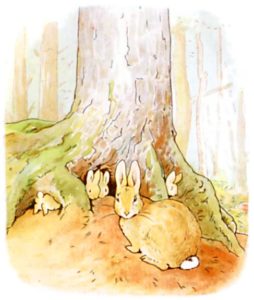 | they lived with their mother in a sand-bank underneath the root of a very Big fir-tree |
Try these suggestions for getting ‘minded to check what they do’ going.
Read a story about revising:
A fine day out [PDF]Try this short activity – Story Bag
Story Bag [PDF]Do some cooking
Cooking is a very real way for young children to understand the need to check progress and make changes if necessary. First decide on the recipe you are going to use and then decide what you could change that would make the children realise the need to check and change things. Maybe you can make the oven temperature too hot or measure the wrong amount of flour or water etc. It may seem a bit wasteful to deliberately burn/spoil the first batch but that only needs to happen with the first lot and then each succeeding group can be doing the checking.
Show and talk about this animation
Find well known stories that encapsulate reflection on revising.
Redraft displays to illustrate work in progress
Collect and display work at different stages of development, with arrows and notes highlighting changes and their impact. Refer to these to encourage students to review and amend their work. Provide guidelines with questions they can ask themselves or each other at different stages in the process. Show that you do not expect perfection at a first attempt!
Talk about success criteria
Make it clear to students what you are looking for in a piece of work and give them opportunities to check their work against the criteria, either individually or in pairs. Ensure the criteria are linked to the original learning intention. Knowing what is expected encourages students to stay on focus and to revise their work to meet the criteria. Invite students to create success criteria themselves in order to encourage ownership.
Include
- what students should know
- how much, and how, they should include opinions, judgements and their own thinking
- what skills they should be able to demonstrate
- how to link the outcome to the original learning intention.
Think pair share
- Offer students a problem or question which is more substantial than simple recall.
- Allow individual think time to engage with the question.
- Students turn to their ‘Learning Partner’ and share ideas, discuss, clarify, challenge etc.
- The pair share with another pair, and subsequently with the whole class to arrive at a range of possible answers.
- At each point students are exposed to the views of others which encourages them to revise and refine their initial thinking.
Combat fear of failure
Celebrate making mistakes. Here is a classroom display which does just that.
Learning Mats
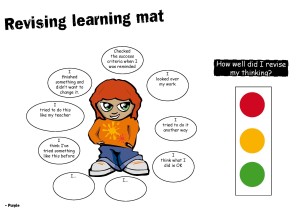 Learning mats are A3 or A4 laminated sheets that show various aspects of a learning habit. They are kept on desks or used as part of wall display.
Learning mats are A3 or A4 laminated sheets that show various aspects of a learning habit. They are kept on desks or used as part of wall display.
Students refer to them during lessons, using them to prompt the learning behaviour being stretched.
They also help to spread the school’s common language for learning and encourage meta-cognitive talk.
This Revising mat suggests early behaviours.
To nudge students from Grey to Purple, use language like:
- Have you noticed the success criteria?;
- Why not have another go?;
- We often don’t get it right first time;
- How are you getting on?;
- What do we mean by ‘being on track?’;
- What is working well for you here?;
- Remember to ask yourself ‘Is this going OK?’
- That’s very close to the right/model answer. What would make it even closer?
- It’s okay to make mistakes.
To set an If/Then target from Grey to Purple, try:
If my teacher offers me advice, then I will think about what they say because they are trying to help me.
If I’m not sure if it’s right, then I’ll check the goal/objective/criteria/example.
Section 4: Team reflection and planning
Session agenda
If this team session is your first one in Stepping Stones phase 2, miss out item 2.
1. Session objectives. What do we want to achieve? ( 5 mins)
2. Sharing classroom experiments. How did our experiments go? ( 20 mins)
Share
- the changes in practice you tried
- how students reacted
- what you learned
- what next as a result
Probe
- what was getting in the way?
- what seemed difficult?
- what would make it easier?
- what made it work particularly well?
- why it was successful?
- changes in your behaviour
Explore the impacts you noticed
- improvements in students’ behaviour
- increased time on task
- greater acceptence of their responsibility in learning
- more enjoyment in learning
- greater effort to improve their learning
- more willingness to ask questions to find out more
- greater willingness to try, and try different ways
- Avoidance of…..
- Improvements in……
- Increases in…….
- Little of no changes in…
3. Recapping on-line materials. What did we think of the materials? ( 15 mins)
Reactions to
- The revising grid
- Where students are secure
- Classroom culture ideas
- Activities and talk ideas
4. Planning what to do. What do we need to do next? ( 10 mins )
Decide
- Which ideas should we all adopt as a school strategy?
- How the progression of revising should be built across the school. ie how the phases of revising might play out against key stages and even year groups.
5. Personal action planning. What am I going to do? ( 20 mins )
Consider
- how you want your pupils to improve/develop/enhance their approach to revising?
- what you are going to do to bring this about?
- develop your enquiry question.
Think of it like this…
If I do XXXX will it improve/develop/enhance YYYY
This is the crunch question. Your pupils are unlikely to change unless you change!
Capture your learning enquiry as a question
Developing an enquiry question Revising.pdfand put a short enquiry plan together

Revising Personal Action Plan.pdfImprovement indicators to consider for Revising
- Increased time on task
- Greater care
- Willingness to try again
- Willingness to try new ways
- More confidence
- Use of checklists
- Understanding of when something is ‘good enough’
- Less rush to finish quickly
- Increased desire to do a good job
- others you want to observe…..
6. Evaluate team session, How did we do as a team? ( 5 mins )
We wish you well with your rich activity/learning enquiry. Do let us know how it went…
Maybe you would like to write a blog about it to feature on our website for the benefit of the Building Learning Power community.
Please contact us to learn how this programme can benefit learning in your school…

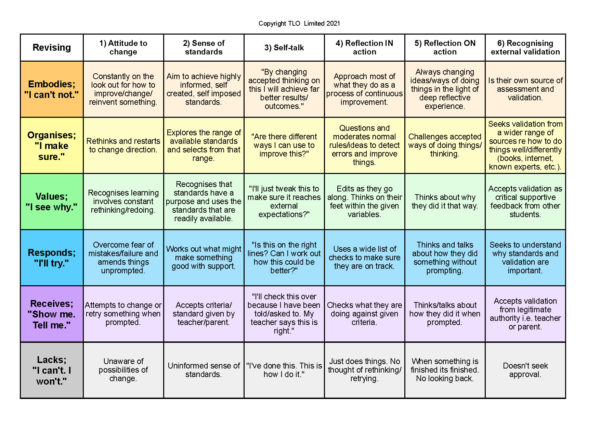
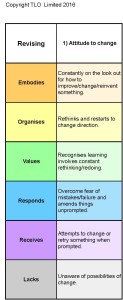
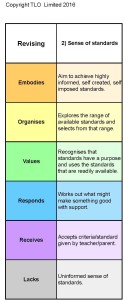
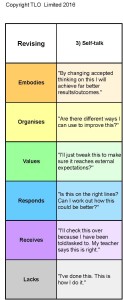
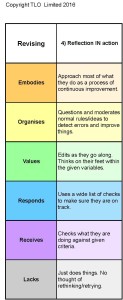
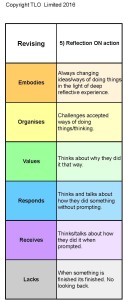
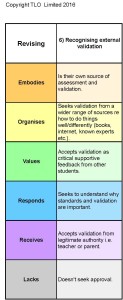

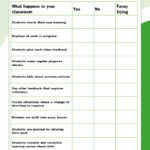

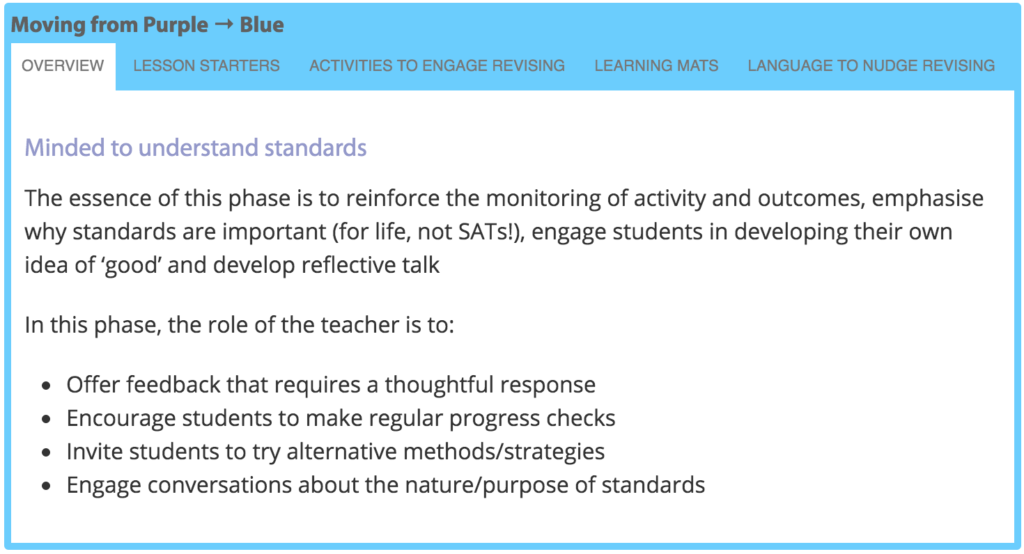
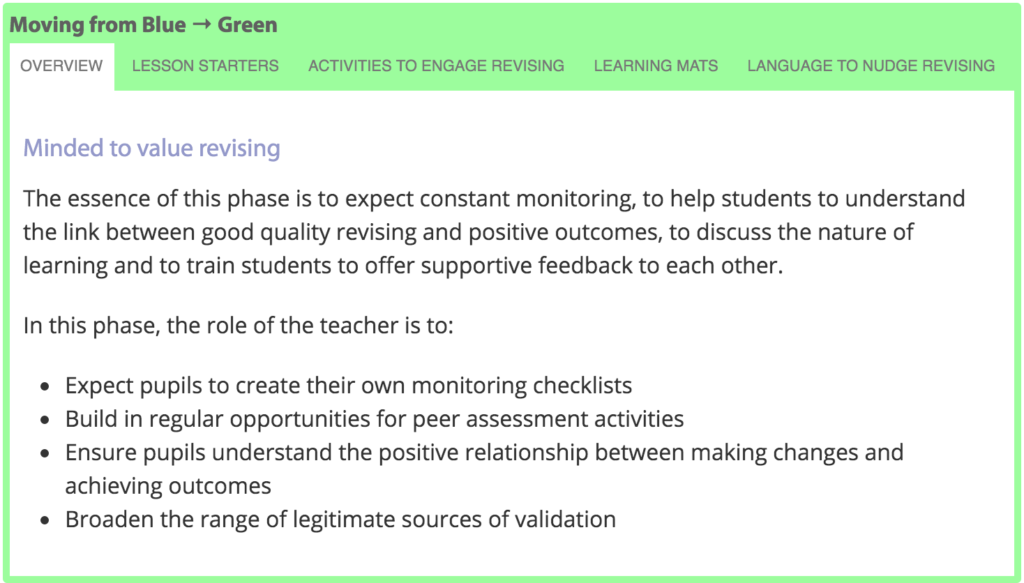
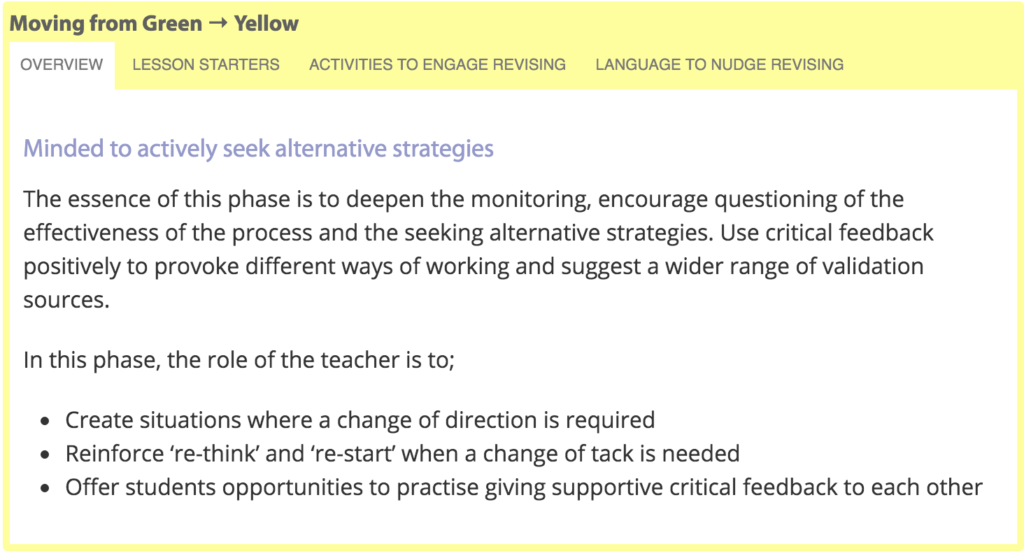
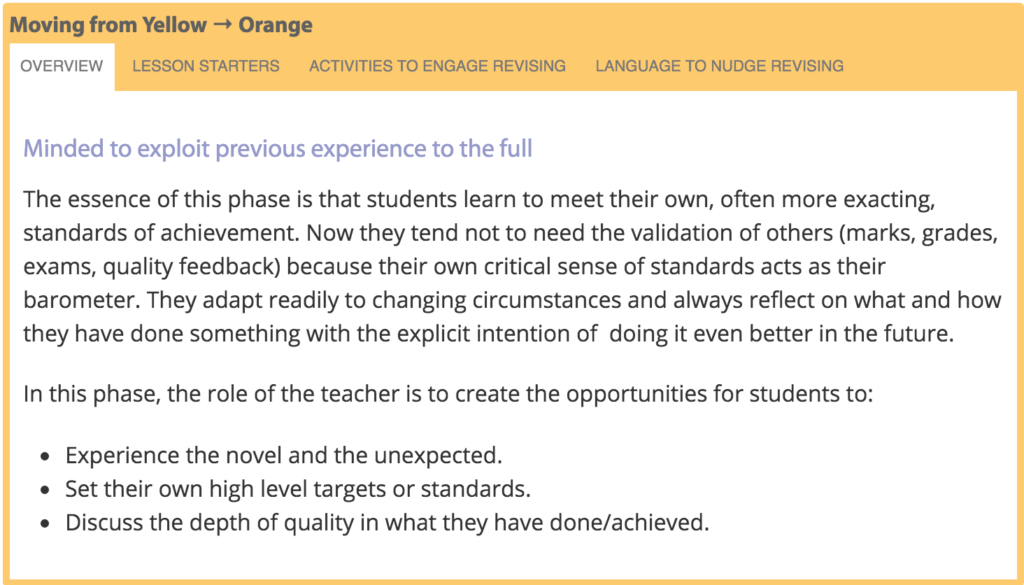
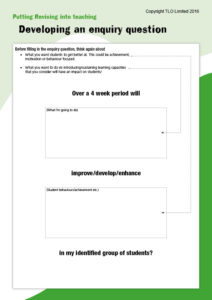
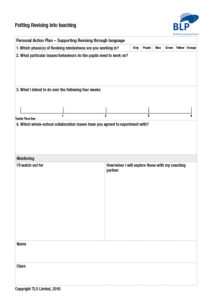
Comments are closed.